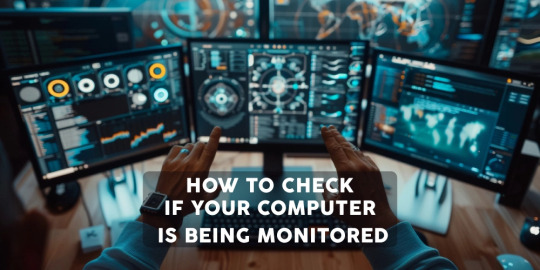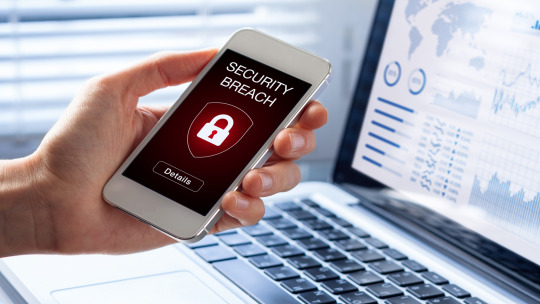#malware detection
Explore tagged Tumblr posts
Text
How to check if your computer is being monitored
In today's digital age, the issue of privacy and security is more pressing than ever. Whether you’re a casual user or a professional, understanding if your computer is being monitored is crucial. This guide will delve into the signs of monitoring, tools to detect it, and steps to safeguard your privacy.

Understanding Computer Monitoring
Before diving into the signs and detection methods, it’s essential to understand what computer monitoring entails. Monitoring can involve tracking your online activity, keystrokes, file access, and even webcam usage. This can be done by malicious software (malware), spyware, or legitimate monitoring software used by employers or parents.
Types of Monitoring
Malware and Spyware: These are malicious programs that can be installed without your knowledge. They can track your activities and send data back to an attacker.
Keyloggers: This type of software records keystrokes, capturing sensitive information like passwords and personal messages.
Remote Access Tools (RATs): These tools allow someone to control your computer remotely, monitoring your screen, accessing files, and even using your webcam.
Legitimate Monitoring Software: Often used in corporate environments, this software tracks employee activity for productivity or compliance reasons. While legal, it can still infringe on personal privacy.
Signs That Your Computer May Be Monitored
Recognizing the signs that your computer might be monitored is the first step in protecting yourself.
1. Unusual System Behavior
Slow Performance: If your computer suddenly becomes sluggish, it might be due to monitoring software consuming resources.
Frequent Crashes or Freezes: Unexpected system crashes can indicate underlying issues, including malware.
2. Suspicious Programs
Unknown Applications: Check your installed programs for any unfamiliar applications. Many monitoring tools disguise themselves as legitimate software.
High Resource Usage: Use the Task Manager (Windows) or Activity Monitor (Mac) to look for processes consuming excessive CPU or memory.
3. Network Activity
Unexplained Network Traffic: Use network monitoring tools to check for unusual data being sent or received. High outbound traffic could indicate that data is being transmitted without your consent.
Blocked Ports: Monitoring software often uses specific ports to communicate. If you notice blocked ports that you didn’t configure, it could be a red flag.
4. Webcam and Microphone Behavior
Indicator Light Activation: If your webcam or microphone is being accessed without your knowledge, the indicator light may be on even when you're not using it.
Unexpected Recordings: Check for unusual files that could be recordings made by your microphone or webcam.
5. Browser Behavior
Unusual Browser Extensions: Check for extensions you didn’t install. Some can track your browsing activity.
Unexpected Redirects: Frequent redirects to strange sites or altered search results can indicate tracking.
6. Security Alerts
Antivirus Notifications: If your antivirus software frequently alerts you about threats, it may indicate that monitoring software is present.
Firewall Alerts: Unusual outgoing connection attempts can suggest that an unauthorized program is trying to access the internet.
Tools to Detect Monitoring Software
If you suspect that your computer is being monitored, several tools can help you investigate further.
1. Antivirus and Anti-Malware Software
Using a reliable antivirus or anti-malware program can help detect and remove malicious software. Some popular options include:
Malwarebytes: Excellent for detecting and removing malware and spyware.
Norton: Offers comprehensive protection against various types of threats.
2. Network Monitoring Tools
Tools like Wireshark can help analyze network traffic and identify suspicious activity. You can monitor data packets to see if there are any unexpected connections.
3. Task Manager / Activity Monitor
Regularly check the Task Manager (Windows) or Activity Monitor (Mac) for processes that look unfamiliar or suspicious. Research any questionable applications before taking action.
4. System Scans
Use built-in tools to perform system scans:
Windows Defender: Run a full scan for malware and spyware.
Mac’s Built-in Security Features: Use the Malware Removal Tool for additional scanning.
5. Firewall Monitoring
Make sure your firewall is active and monitor logs for any unusual activity. A firewall can block unauthorized access attempts and alert you to potential threats.
Steps to Protect Your Privacy
If you determine that your computer is being monitored or you want to prevent it from happening, follow these steps to enhance your security.
1. Update Your Software Regularly
Keeping your operating system and all software up-to-date ensures that you have the latest security patches. This reduces vulnerabilities that can be exploited by monitoring tools.
2. Use Strong Passwords
Implement strong, unique passwords for all your accounts and devices. Consider using a password manager to generate and store complex passwords securely.
3. Enable Two-Factor Authentication
Two-factor authentication (2FA) adds an extra layer of security by requiring a second form of verification, making unauthorized access much more difficult.
4. Install a Firewall
Ensure you have a firewall activated, whether it’s built-in (like Windows Firewall) or third-party. This helps control incoming and outgoing network traffic.
5. Be Cautious with Downloads
Avoid downloading software from untrusted sources, as this can introduce malware to your system. Always verify the legitimacy of software before installing it.
6. Regularly Review Permissions
Check application permissions on your device regularly. Revoke access for any apps that do not need to access your camera, microphone, or location.
7. Use a VPN
A Virtual Private Network (VPN) encrypts your internet connection, making it difficult for anyone to monitor your online activities.
8. Educate Yourself
Stay informed about the latest cybersecurity threats and best practices. Knowledge is your best defense against monitoring.
When to Seek Professional Help
If you suspect your computer is being monitored and cannot identify or remove the software yourself, consider seeking professional help. Cybersecurity experts can perform a thorough analysis of your system and provide tailored solutions.
Conclusion
Understanding if your computer is being monitored is vital for protecting your privacy. By recognizing the signs, utilizing detection tools, and implementing security measures, you can safeguard your personal information. Remember, vigilance is key in the ever-evolving landscape of digital security. Stay informed, proactive, and secure in your online presence.
#Computer Security#Online Privacy#Cybersecurity#Monitoring Software#Malware Detection#Privacy Protection#Digital Security#Keyloggers#Network Monitoring#Antivirus#VPN#Internet Safety#Personal Data Security#Remote Access Tools#Digital Awareness
2 notes
·
View notes
Text
https://digimob.com.au/signs-of-malware-on-phone-or-laptop

#Phone Repair#Laptop Repair#Malware Detection#Mobile Security#Computer Security#Virus Removal#Tech Tips#Device Troubleshooting#Cyber Threats#Phone Performance Issues#Laptop Running Slow#Data Protection#Digimob Phone Repair#Device Malware Signs#Professional Repair Services
0 notes
Text
As the city's burger joints thrived, the ripple effect was felt across other sectors.
#Covert Communication#cybercrime#Cybersecurity#Digital Watermarking#encryption#Hidden Messages#information security#malware detection#Steganography
0 notes
Text
Understanding Network Sandboxes: Enhancing Cybersecurity for Businesses
In today’s digital landscape, cybersecurity is a growing concern for organizations of all sizes. As businesses continue to expand their digital footprint, cyber threats evolve, becoming more sophisticated and harder to detect. This is where network sandboxes play a critical role in ensuring the safety and security of sensitive data and IT infrastructures. What is a Network Sandbox? A network…
#advanced protection#automated threat detection#behavioral analysis#business cybersecurity#Cybersecurity#Fiber Internet#IT security#malware detection#network sandbox#Network Security#real-time security solutions#SolveForce#zero-day threats
0 notes
Link
URL Antivirus Scanner - Ensure a Secure Browsing Experience
#URL Antivirus Scanner#Free Micro Tools#online safety#website security#virus scan#malware detection#SEO tools#secure browsing
0 notes
Text







[...MALWARE DETECTED...]
[...INSTALLING TEMPORARY ANTIVIRUS...]
[..REBOOTING...]
#smg4 mr puzzles#smg4 fanart#gmod#smg4#gmod screenshot#mr. puzzles#gmod art#mr puzzles#change in script#ask creator of change in script#ask change in script#malware detected
69 notes
·
View notes
Text


What if he was human chat (he is human)
#tropical's art#digital art#art#collinlock16#minecraft arg but the protagonist is tired#I also find it super interesting that Kevin somehow made an antivirus that can detect entities#And in general just seems like a pretty solid antivirus#I also find it interesting that Digital Satan was a type of Malware (Worm) that also just so happened to be a sentient AI#Which I guess isn't really a paranormal entity#But falls under it I reckon#Do other entities have Malware classifications (that would be quite funny)#(Though only if the Kevin antivirus picks it up)#Kevin stop being a paranormal mercenary the cybersecurity world needs you#He is now a Computer Science major (headcanon) (dude should be in the industry) (he is a coder) (what a nerd)
70 notes
·
View notes
Text
You guys think Kinito has an intense fear of fire?

#my art#kinitopet#kinito the axolotl#tw fire#fire#I think he should have a big fear of large fires#give that malware a phobia.#give him trauma that makes him wake your pc up while screaming bloody murder because he could feel a component heating up too much#have him get horribly anxious anytime he can detect the monitor getting hot or the pc running a little too hard#anything to avoid the flames. not again. not ever again. please.
89 notes
·
View notes
Text

Guys my tumblr is being weird, I recently did a system restore on my PC and I noticed the Home and Customize icons in the top right are gone...and when I go to someone's blog the like, reblog and follow icons that are usually seen in the top right aren't showing, how do I get them back? ;; Can't even edit a post through my blog (in this format) either...
It's not just for this blog but for all my blogs there's no icons in the top right
Please tell me someone here can help
#i'm actually gonna fucking cry#istg my PC has been so weird this past week it's stressing me the hell out#the system restore has made things worse...#i've been doing a shit ton of scans and no malware or viruses have been detected but chrome especially has been odd so I'm using firefox#one minute it was fine the next it's started tweaking and i haven't changed anything#i'm literally getting ill from worry
13 notes
·
View notes
Note
hello tumblr user faggotyuri. square up im waiting for you in a parking lot somewhere
wait i cant fight cant we just kiss instead
18 notes
·
View notes
Text
15 Best Free Resources for Malicious URLs and Phishing Links for Cybersecurity Testing
In today’s rapidly evolving cybersecurity landscape, having access to reliable sources of malicious URLs, phishing links, and malware samples is essential for security professionals, penetration testers, and IT administrators. Whether you’re validating your security controls, conducting security awareness training, or researching new threat vectors, accessing known malicious content in a…
#cyber threats#cybersecurity#ethical hacking#malicious URLs#malware analysis#malware samples#penetration testing#phishing detection#phishing links#security controls#security testing#security tools#security validation#threat intelligence#web security
2 notes
·
View notes
Text
Cybersecurity in the Age of AI: Navigating New Threats

Understanding AI-Driven Cyber Threats and Defense Strategies
Introduction: A New Cybersecurity Landscape in the Age of AI
Artificial Intelligence (AI) has revolutionized industries worldwide by enhancing efficiency, accuracy, and innovation. From automating routine tasks to enabling predictive analytics, AI continues to unlock unprecedented opportunities. However, as AI becomes deeply embedded in our digital ecosystems, it also reshapes the cybersecurity landscape bringing both powerful defenses and novel risks.
The rise of AI-driven cybersecurity tools is transforming how organizations detect, respond to, and prevent cyber threats. Machine learning algorithms can analyze massive datasets to identify unusual patterns, predict attacks, and automate defenses in real time. Yet, the same AI advancements also equip cybercriminals with sophisticated capabilities enabling automated phishing, intelligent malware, and adaptive intrusion techniques that are harder to detect and mitigate.
This dual-edged nature of AI demands a new approach to cyber threat intelligence, risk management, and security strategy. Organizations must stay vigilant and adopt innovative solutions to safeguard sensitive data and infrastructure against increasingly complex and automated cyberattacks.
For a deeper understanding of how AI is reshaping cybersecurity, check out NIST’s AI and Cybersecurity Framework.
How AI Is Changing Cybersecurity: Defense and Threat Evolution
Artificial Intelligence is revolutionizing cybersecurity by playing a dual role empowering defenders while enabling more sophisticated cyberattacks. On the defense front, AI-powered cybersecurity systems leverage machine learning and data analytics to process enormous volumes of network traffic, user activity, and threat intelligence in real time. These systems excel at detecting anomalies and predicting potential threats far faster and more accurately than traditional signature-based methods.
For example, AI-driven tools can identify subtle patterns indicative of phishing attacks, ransomware activity, or unusual network intrusions, often flagging risks before they escalate into full-blown breaches. Automated incident response capabilities enable rapid containment, minimizing damage and reducing reliance on manual intervention.
However, cybercriminals are equally quick to adopt AI technologies to enhance their offensive tactics. By using AI-generated content, hackers craft convincing phishing emails and social engineering schemes that trick users more effectively. AI can also be used to bypass biometric systems, automate vulnerability scanning, and mimic legitimate user behaviors to avoid detection by conventional security measures. This escalating “arms race” between attackers and defenders underscores the critical need for adaptive cybersecurity strategies.
To explore the evolving interplay between AI and cyber threats, consider reviewing insights from the Cybersecurity & Infrastructure Security Agency (CISA).
Emerging AI-Powered Threats: Deepfakes, Adaptive Malware, and Automated Attacks
The cybersecurity landscape faces increasingly sophisticated challenges due to the rise of AI-powered threats. Among the most alarming is the use of deepfakes hyper-realistic synthetic media generated by AI algorithms that can convincingly impersonate individuals. These deepfakes are weaponized for identity theft, social engineering schemes, or disinformation campaigns designed to manipulate public opinion or corporate decision-making. The growing prevalence of deepfakes adds a dangerous new dimension to phishing and fraud attempts.
In addition, AI-driven adaptive malware is evolving rapidly. Unlike traditional viruses, this malware can modify its code and behavior dynamically to evade signature-based antivirus software and intrusion detection systems. This makes infections more persistent and difficult to eradicate, posing a serious risk to personal, corporate, and government networks.
Furthermore, automated hacking tools powered by AI significantly accelerate cyberattacks. These intelligent systems can autonomously scan vast networks for vulnerabilities, execute targeted breaches, and learn from unsuccessful attempts to improve their strategies in real time. This capability enables hackers to conduct highly efficient, large-scale attacks that can quickly overwhelm human cybersecurity teams.
For more insights into the risks posed by AI-powered cyber threats and how to prepare, visit the National Institute of Standards and Technology (NIST).
Strengthening Cyber Defenses with AI: The Future of Cybersecurity
Despite the growing threat landscape driven by AI-powered attacks, artificial intelligence remains a crucial asset for cybersecurity defense. Cutting-edge security systems leverage AI technologies such as real-time threat intelligence, automated incident response, and predictive analytics to detect and neutralize cyber threats faster than ever before. By continuously analyzing vast amounts of data and learning from emerging attack patterns, AI enables organizations to anticipate and prevent breaches before they occur.
One of the most effective approaches is the integration of AI with human expertise, forming a hybrid defense model. In this setup, cybersecurity analysts harness AI-generated insights to make critical decisions, prioritize threats, and customize response strategies. This synergy balances the rapid detection capabilities of AI with the nuanced judgment of human operators, resulting in more accurate and adaptive cybersecurity posture.
Organizations that adopt AI-driven security platforms can significantly reduce response times, improve threat detection accuracy, and enhance overall resilience against sophisticated attacks.
For organizations seeking to implement AI-based cybersecurity solutions, resources like the Cybersecurity and Infrastructure Security Agency (CISA) offer valuable guidance and best practices.
Ethical and Privacy Considerations in AI-Driven Cybersecurity
As organizations increasingly integrate artificial intelligence in cybersecurity, important ethical and privacy concerns arise. The process of collecting and analyzing vast datasets to identify cyber threats must be carefully balanced with safeguarding user privacy rights and sensitive information. Maintaining transparency in AI decision-making processes is crucial to build trust and accountability. Clear regulatory frameworks, such as the General Data Protection Regulation (GDPR), provide guidelines that help organizations use AI responsibly while respecting individual privacy.
Additionally, organizations face risks associated with over-automation in cybersecurity. Relying solely on AI systems without sufficient human oversight can result in missed threats, false positives, or biased decision-making. These errors may lead to security vulnerabilities or negatively impact the user experience. Therefore, a balanced approach combining AI’s speed and scale with human judgment is essential for ethical, effective cybersecurity management.
By prioritizing ethical AI use and privacy protection, businesses can foster safer digital environments while complying with legal standards and maintaining customer confidence.
Preparing for the Future of AI and Cybersecurity
As artificial intelligence continues to transform the cybersecurity landscape, organizations must proactively prepare for emerging challenges and opportunities. Investing in continuous learning and regular employee cybersecurity training ensures teams stay equipped to handle evolving AI-powered threats. Developing flexible security architectures that seamlessly integrate AI-driven tools enables faster threat detection and response, improving overall resilience.
Collaboration across industries, governments, and academic researchers is critical for creating shared cybersecurity standards, real-time threat intelligence sharing, and innovative defense strategies. Initiatives like the Cybersecurity and Infrastructure Security Agency (CISA) promote such partnerships and provide valuable resources.
For individuals, maintaining strong cybersecurity hygiene using strong passwords, enabling multi-factor authentication (MFA), and practicing safe online behavior is more important than ever as attackers leverage AI to launch more sophisticated attacks.
By combining organizational preparedness with individual vigilance, we can build a safer digital future in an AI-driven world.
Conclusion: Embracing AI to Navigate the New Cybersecurity Threat Landscape
Artificial Intelligence is fundamentally reshaping the cybersecurity landscape, introducing both unprecedented opportunities and significant risks. While cybercriminals increasingly use AI-driven techniques to execute sophisticated and automated attacks, cybersecurity professionals can harness AI-powered tools to create smarter, faster, and more adaptive defense systems.
The key to success lies in adopting AI thoughtfully blending human expertise with intelligent automation, and maintaining continuous vigilance against emerging threats. Organizations that invest in AI-based threat detection, real-time incident response, and ongoing employee training will be better positioned to mitigate risks and protect sensitive data.
By staying informed about evolving AI-driven cyber threats and implementing proactive cybersecurity measures, businesses and individuals alike can confidently navigate this dynamic digital frontier.
For further insights on how AI is transforming cybersecurity, explore resources from the National Institute of Standards and Technology (NIST).
FAQs
How is AI changing the cybersecurity landscape? AI is transforming cybersecurity by enabling faster threat detection, real-time response, and predictive analytics. Traditional systems rely on static rules, but AI adapts to evolving threats using machine learning. It can scan vast datasets to identify anomalies, spot patterns, and neutralize potential attacks before they spread. However, AI is also used by hackers to automate attacks, create smarter malware, and evade detection. This dual-use nature makes cybersecurity both more effective and more complex in the AI era, demanding constant innovation from defenders and responsible governance around AI deployment.
What are the biggest AI-powered cybersecurity threats today? AI can be weaponized to launch sophisticated cyberattacks like automated phishing, deepfake impersonations, and AI-driven malware that adapts in real time. Hackers use AI to scan networks for vulnerabilities faster than humans can react. They also employ natural language models to craft realistic phishing emails that bypass traditional filters. Deepfakes and synthetic identities can fool biometric security systems. These AI-enhanced threats evolve quickly and require equally intelligent defense systems. The speed, scale, and realism enabled by AI make it one of the most significant cybersecurity challenges of this decade.
How does AI improve threat detection and response? AI boosts cybersecurity by analyzing massive volumes of network traffic, user behavior, and system logs to detect anomalies and threats in real time. It identifies unusual patterns like logins from strange locations or data spikes and flags them before they escalate into breaches. AI can also automate responses, isolating infected devices, updating firewalls, or sending alerts instantly. This proactive approach dramatically reduces reaction times and false positives. In large enterprises or cloud environments, where manual monitoring is nearly impossible, AI acts as a 24/7 digital watchdog.
Can AI prevent phishing and social engineering attacks? Yes, AI can help identify phishing attempts by scanning emails for suspicious language, links, or metadata. Natural language processing (NLP) models are trained to detect tone, urgency cues, or fake URLs often used in phishing. AI can also assess sender reputations and flag unusual communication patterns. While it can’t fully prevent human error, it significantly reduces exposure by quarantining suspicious emails and alerting users to risks. As phishing tactics evolve, so does AI constantly learning from past attacks to improve prevention accuracy.
Are AI-based cybersecurity tools available for small businesses? Absolutely. Many affordable, AI-powered security tools are now available for small and mid-sized businesses. These include smart antivirus software, behavior-based threat detection, AI-driven email filters, and endpoint protection platforms that learn from each user’s habits. Cloud-based solutions like Microsoft Defender, SentinelOne, and Sophos offer AI-powered features tailored for SMBs. They provide enterprise-grade security without the need for in-house security teams. With cyberattacks increasingly targeting smaller firms, AI-based solutions are not just accessible they’re essential for staying protected with limited resources.
Can AI replace cybersecurity professionals? AI enhances cybersecurity but won’t replace human experts. While it automates routine tasks like threat detection, data analysis, and basic response, human oversight is still crucial for judgment, strategy, and interpreting complex risks. Cybersecurity professionals work alongside AI to investigate incidents, fine-tune models, and ensure compliance. In fact, AI allows professionals to focus on high-level security architecture, incident response, and governance rather than tedious monitoring. The future lies in a human-AI partnership where AI handles scale and speed, and humans manage context and ethical oversight.
What are some ethical concerns with using AI in cybersecurity? Ethical concerns include data privacy, surveillance overreach, and algorithmic bias. AI systems require vast amounts of data, which can lead to privacy violations if not managed properly. There’s also the risk of false positives that could unjustly flag innocent users or systems. If left unchecked, AI could reinforce existing biases in threat detection or lead to disproportionate responses. Moreover, governments and companies may use AI tools for excessive surveillance. Responsible AI in cybersecurity means transparency, data governance, user consent, and fairness in decision-making.
How do hackers use AI to their advantage? Hackers use AI to create more sophisticated and scalable attacks. For instance, AI-powered bots can probe systems for weaknesses, bypass CAPTCHAs, and execute brute-force attacks faster than humans. NLP models are used to generate realistic phishing emails or impersonate voices using deepfakes. Machine learning helps malware adapt its behavior to avoid detection. These tools allow cybercriminals to attack with greater precision, volume, and deception making AI both a powerful ally and a formidable threat in the cybersecurity battlefield.
What is AI-driven threat hunting? AI-driven threat hunting involves proactively seeking out hidden cyber threats using machine learning and behavioral analytics. Instead of waiting for alerts, AI scans systems and networks for subtle anomalies that indicate intrusion attempts, dormant malware, or lateral movement. It uses predictive modeling to anticipate attack paths and simulate threat scenarios. This proactive approach reduces the risk of long-term undetected breaches. By continuously learning from new threats, AI enables security teams to shift from reactive defense to predictive offense, identifying threats before they do damage.
How can organizations prepare for AI-powered cyber threats? Organizations should invest in AI-powered defenses, regularly update their threat models, and train employees on AI-enhanced risks like deepfakes or phishing. Cybersecurity teams need to adopt adaptive, layered security strategies that include AI-based detection, behavioral monitoring, and automated response. It's also crucial to perform AI-specific risk assessments and stay informed about new threat vectors. Partnering with vendors that use explainable AI (XAI) helps ensure transparency. Finally, fostering a cyber-aware culture across the organization is key because even the smartest AI can’t protect against careless human behavior.
#AI cybersecurity threats#artificial intelligence in security#AI-driven cyber attacks#cybersecurity in AI age#AI-powered threat detection#digital security and AI#AI-based malware protection#evolving cyber threats AI#AI cyber defense tools#future of cybersecurity AI
0 notes
Text
How to Use AI to Predict and Prevent Cyberattacks
In today’s rapidly evolving digital landscape, cyberattacks are becoming more frequent, sophisticated, and devastating. As businesses and individuals increasingly rely on technology, the need to bolster cybersecurity has never been more critical. One of the most promising solutions to combat this growing threat is Artificial Intelligence (AI). AI can enhance cybersecurity by predicting,…
#AI cybersecurity solutions#AI for cybersecurity#AI in fraud detection#AI threat detection#Check Point Software#Cisco#CrowdStrike#Darktrace#FireEye#Fortinet#IBM Security#machine learning in cybersecurity#malware detection with AI#McAfee#Microsoft Defender#Palo Alto Networks#predict cyberattacks with AI#prevent cyberattacks with AI#Qualys#SentinelOne#Sophos#Trend Micro#Zscaler.
0 notes
Video
youtube
Spyware Could Be Spying on Your Phone Right Now! Here’s How to Kick It t...
#youtube#Spyware Phone Security Privacy Malware Data Protection Threats Detect Remove Safe Cyber Alert
0 notes
Text
K7 Total Security for Windows
K7 Total Security is a comprehensive cybersecurity solution developed by K7 Computing to provide multi-layer protection for personal computers. With over three decades of expertise, K7 Total Security leverages advanced technologies, such as Cerebro Scanning, to deliver robust defense against evolving malware and cybersecurity threats. Key Features of K7 Total Security 1. Real-Time Threat…
#AI-based security#best cybersecurity tools#Cerebro Scanning#cybersecurity software#K7 Total Security#malware protection#online transaction security#parental control software#privacy protection#real-time threat detection
0 notes